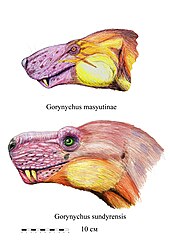| Gorynychus Temporal range:
| |
|---|---|

| |
| Holotype skull of G. masyutinae | |
| Scientific classification | |
| Domain: | Eukaryota |
| Kingdom: | Animalia |
| Phylum: | Chordata |
| Clade: | Synapsida |
| Clade: | Therapsida |
| Clade: | †Therocephalia |
| Genus: | †Gorynychus Kammerer & Masyutin, 2018 |
| Type species | |
| †Gorynychus masyutinae Kammerer & Masyutin, 2018
| |
| Other species | |
| |
Gorynychus is a genus of therocephalian from the mid-Permian from Kotelnich, Russia. The genus contains two species, G. masyutinae and G. sundyrensis. It was named after the three-headed dragon Zmey Gorynych (Змей Горыныч) from Russian mythology.[1][2][3]
Description
[edit]
G. masyutinae, only known from its holotype, was wolf-sized and appears to have represented the largest predator in the Kotelnich fauna. Like many theriodonts, it had strongly developed and prominent canine teeth.[1]
Paleoecology
[edit]The discovery of such a large therocephalian as the apex predator of its environment coupled with the discovery of a smaller gorgonopsid, the smaller and nocturnal Nochnitsa, in the same formation indicates that a faunal turnover was occurring at the time, with gorgonopsians taking over the therocephalians' role as the dominant predators in their environment.[2]
References
[edit]- ^ a b Kammerer, CF; Masyutin, V. (2018). "A new therocephalian (Gorynychus masyutinae gen. et sp. nov.) from the Permian Kotelnich locality, Kirov Region, Russia". PeerJ. 6: e4933. doi:10.7717/peerj.4933. PMC 5995100. PMID 29900076.
- ^ a b North Carolina Museum of Natural Sciences (June 8, 2018). "'Monstrous' new Russian saber-tooth fossils clarify early evolution of mammal lineage". ScienceDaily. Retrieved June 13, 2018.
- ^ Suchkova, J.A.; Golubev, V.K. (2019). "New Permian therocephalian (Therocephalia, Theromorpha) from the Sundyr Assemblage of Eastern Europe". Paleontological Journal (4): 87–92. doi:10.1134/S0031031X19040123.





Well, that’s interesting to know that Psilotum nudum are known as whisk ferns. Psilotum nudum is the commoner species of the two. While the P. flaccidum is a rare species and is found in the tropical islands. Both the species are usually epiphytic in habit and grow upon tree ferns. These species may also be terrestrial and grow in humus or in the crevices of the rocks.
View the detailed Guide of Psilotum nudum: Detailed Study Of Psilotum Nudum (Whisk Fern), Classification, Anatomy, Reproduction